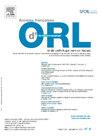再发表:评估骨传导oVEMPs使用额内侧和乳突刺激
Q4 Medicine
Annales Francaises d''Oto-Rhino-Laryngologie et de Pathologie Cervico-Faciale
Pub Date : 2025-03-26
DOI:10.1016/j.aforl.2025.03.001
引用次数: 0
摘要
目的确定改良裂隙灯座额骨刺激的最佳刺激强度,比较额骨内侧和乳突两个刺激部位骨传导眼前庭诱发肌源性电位(oVEMPs)的可靠性和对称性。方法本观察性研究纳入33名健康志愿者(15名女性,18名男性;平均年龄24.5岁)在洛桑大学医院。参与者接受了耳神经学评估,结果正常的参与者也被纳入其中。骨传导ovemp使用br本文章由计算机程序翻译,如有差异,请以英文原文为准。
Republication de : Evaluation of bone-conducted oVEMPs using frontal medial and mastoid stimulations
Aims
To determine the optimal stimulation intensity for frontal stimulation with a modified slit lamp holder and to compare the reliability and symmetry of bone-conducted ocular vestibular evoked myogenic potentials (oVEMPs) using two stimulation sites: frontal medial and mastoid.
Methods
This observational study included 33 healthy volunteers (15 women, 18 men; mean age 24.5 years) at the University Hospital of Lausanne. Participants underwent otoneurological assessments, and those with normal results were included. Bone-conducted oVEMPs were recorded using a Brüel and Kjaer mini-shaker type 4810. A modified slit lamp holder was used for frontal stimulation to ensure consistent application pressure, freeing the examiner's hands. Mastoid stimulation was performed manually.
Results
The best reproducibility of oVEMP recordings was observed at 70 dB nHL. Frontal stimulation demonstrated lower dispersion of data and lower asymmetry ratios of latencies (up to 7%) and amplitudes (up to 50%) compared to mastoid stimulation (up to 40% for latencies). Single stimulations at both frontal and mastoid sites were sufficient to obtain reliable measurements of both utricles.
Conclusion
Frontal stimulation at 70 dB nHL using a modified slit lamp holder is recommended for bone-conducted oVEMP recordings due to its superior reproducibility, comfort, and reliability. This study establishes a new standard for optimal stimulation intensity and supports the use of frontal stimulation in clinical practice.
求助全文
通过发布文献求助,成功后即可免费获取论文全文。
去求助
来源期刊

Annales Francaises d''Oto-Rhino-Laryngologie et de Pathologie Cervico-Faciale
Medicine-Otorhinolaryngology
CiteScore
0.10
自引率
0.00%
发文量
93
审稿时长
51 days
 求助内容:
求助内容: 应助结果提醒方式:
应助结果提醒方式:


